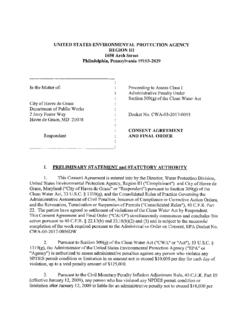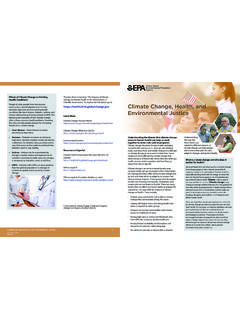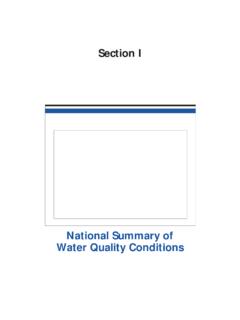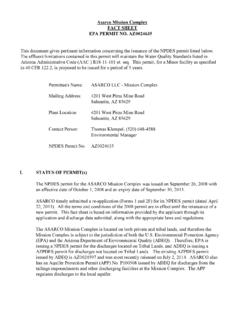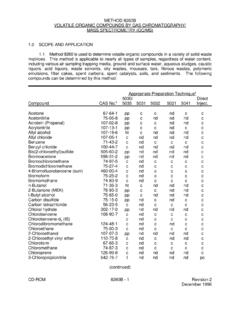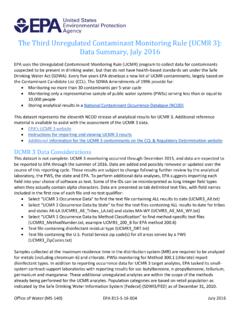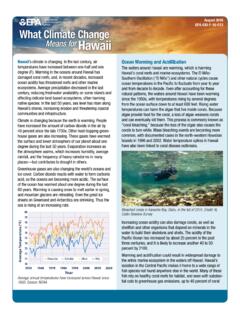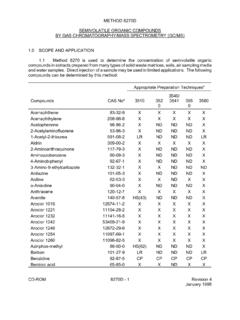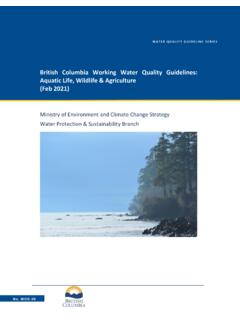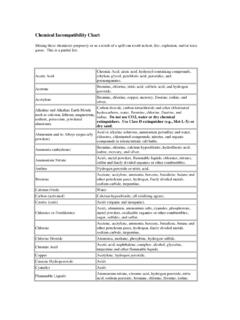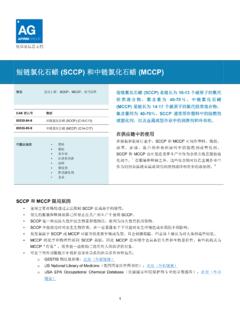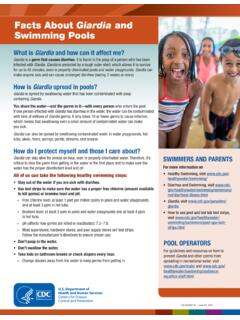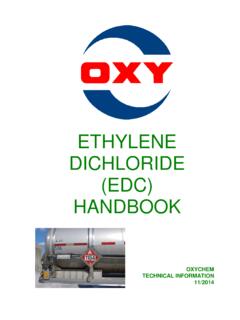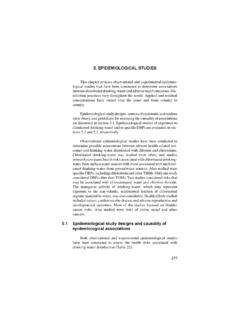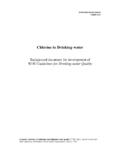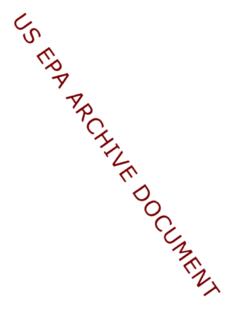Transcription of Toxicity Characteristic Leaching Procedure (TCLP) for VOCs ...
1 Toxicity Characteristic Leaching Procedure ( tclp ) for VOCs, SVOCs, chlorinated Pesticides and Herbicides, and Metals by SW-846 Method 1311 and Analysis Table of Contents Pages SW-846 Methods 1311 tclp and 8260B for Volatile Organic Compounds (VOCs) 2 to 5 SW-846 Methods 1311 tclp and 8270C for Semivolatile Organic Compounds (SVOCs) 6 to 9 SW-846 Methods 1311 tclp and 8081 for chlorinated Pesticides 10 to 13 SW-846 Methods 1311 tclp and 8151A for chlorinated Herbicides 14 to 16 SW-846 Methods 1311 tclp , 6010 for Metals, and 7470/7471 for Mercury 17 to 21 TCLPCRF 1 of 21 Revision 01/28/2000 cTable 1A.
2 Summary of Holding Times and Preservation for tclp Volatile Organic Compounds (VOCs) by SW-846 Method 1311 Analytical Parameter a Technical and Contract Holding Times Preservation b Volatile Organic Compounds (VOCs) in Water Technical for tclp Extraction: 14 days from collection; Contract for tclp Extraction: 10 days from receipt at laboratory; Technical and Contract Analysis: 14 days from date of tclp extraction to analysis. Cool to 4 C 2 C VOCs in Soil c,d Technical and Contract for tclp Extraction: 48 hours cumulative from collection; (7 days if frozen) c Technical and Contract of tclp Extract: 7 days from date of tclp extraction to analysis.
3 Cool to 4 C 2 C; sealed zero headspace containers. C a Individual target compounds are listed in Table Preservatives should not be added to samples before extraction. Freezing of soil samples requires contract Freezing of En Core TM samplers requires contract approval. Data Calculations and Reporting Units: Determine the percent solid as specified in Section of SW-846 Method 1311 and report the result as percent solid. Extract the second sample/aliquot according to Section of SW-846 Method 1311. Calculate the response factor (RF) and the concentration of individual analytes according to the equations specified in Sections and of SW 846 Method 8260B, Volatile Organic Compounds by Gas Chromatography/Mass Spectrometry (GC/MS), (Revision 2).
4 Report final analyte concentration in units of micrograms per liter ( g/L). Report results that are less than 10 g/L to 1 significant figure, and results that are greater than or equal to 10 g/L to 2 significant figures. For rounding results, adhere to the following rules:a) If the number following those to be retained is less than 5, round down; b) If the number following those to be retained is greater than 5, round up; orc) If the number following the last digit to be retained is equal to 5, round down if the digit is even, or round up if the digit is odd. All records of analysis and calculations must be legible and sufficient to recalculate all sample concentrations and QC results.
5 Include an example calculation in the data package. Table 1B. Target Compound List, Contract Required Quantitation Limits TCLPCRF 2 of 21 Revision 01/28/2000 (CRQLs), and Regulatory and Spiking Levels for tclp VOCs by GC/MS Method 8260B Analyte CRQL g/L Regulatory Level mg/L Spiking Level g/L Benzene 10 50 Carbon tetrachloride 10 50 Chlorobenzene 10 100 50 Chloroform 10 50 1,4-Dichlorobenzene 10 50 1,2-Dichloroethane 10 50 1,1-Dichloroethene 10 50 Methyl ethyl ketone 10 200 50 Tetrachloroethene 10 50 Trichloroethene 10 50 Vinyl chloride 10 50 Table 2. Summary of Calibration Procedures for tclp VOCs by SW-846 Method 8260B TCLPCRF 3 of 21 Revision 01/28/2000 Calibration Element Frequency Acceptance Criteria Corrective Action GC/MS Tuning with 4-bromofluorobenzene (BFB) Beginning of each 12 hour period during which standards and samples are analyzed Ion abundance criteria in Table 4 of SW-846 Method 8260B 1.
6 Identify the problem. 2. MS tune criteria must be met before calibration Initial Calibration (minimum blank + 5 points for each analyte) (ICAL) a, b, c Initially; whenever required, due to failure of CCV RSD for RFs #20%; 1. Terminate analysis 2. Recalibrate and verify before sample analysis Continuing Calibration Verification (CCV) Following ICV, every 12-hour, and end of run %D between RF of CCV and avg RFs from ICAL # 15% 1. Recalibrate and verify 2. Reanalyze samples back to last good CCV System Performance Check Compound (SPCC) With ICAL or CCV RF for chloromethane, 1,1-dichloroethane, bromoform, $ ; chlorobenzene, 1,1,2,2 tetrachloroethane, $ 1.
7 Terminate analysis 2. Recalibrate and verify before sample analysis Calibration Check Compounds (CCC) With ICAL or CCV RSD for RFs #30% 1. Terminate analysis 2. Recalibrate and verify before sample analysis Internal Standards Every standard, sample, blank, and QC sample IS area within a factor of two of the IS area in the associated CCV (-50% to +100%) 1. Investigate the system; 2. Re-analyze all samples analyzed during a system malfunction Retention time evaluation of CCV standards Each analysis of CCV standard 3 x the SD of the avg ICAL RT for each analyte 1. Re-calibrate and verify 2. Re-analyze samples back to last good CCV a The ICAL low standard must be above but near the CRQL.
8 The low ICAL standard must have a signal to noise ratio $5:1. If this requirement cannot be met, the laboratory must submit a method detection limit (MDL) study as part of the data ICAL and CCV standards must contain all target analytes listed in Table 1B. c Report the retention time (RT) window for each analyte. Determine RT windows as 3 x the standard deviation (SD) of the average initial calibration RT for each analyte. Table 3. Summary of Internal Quality Control Procedures for tclp VOCs BY SW-846 Method 8260B TCLPCRF 4 of 21 Revision 01/28/2000 QC Element Frequency Acceptance Criteria Corrective Action Method Blank (MB) Each 12-hour time period, minimum of one per SDG a or one per batch of extraction fluid < CRQL for each compound 1.
9 Investigate the source of contamination and document. 2. Reextract and/or reanalyze all samples processed with a blank that is out of control. Matrix Spike and Matrix Spike Duplicate (MS/MSD) b One MS/MSD set per batch or SDG (1 MS/MSD set per 20 samples minimum) Sample extract: 75-125% of expected value; #25% RPD between MS and MSD 1. Report in case narrative Surrogate Spikes b, c Every sample, QC sample, standard and method blank Sample extract: 85-115% of expected value, except for 1,2-dichloroethane (75-115%) 1. Reanalyze all samples with non-compliant surrogate recoveries Laboratory Control Sample (LCS) One per SDG Sample extract: 70-130% of expected value 1.
10 Investigate the source of problem and document. 2. Reanalyze all samples processed with a LCS that is out of control. a SDG - Sample Delivery Group - each case of field samples received; or each 20 field samples within a case; or each 14 calendar day period during which field samples in a case are received. b Spiking solution to be added after the tclp extraction, immediately preceding Toluene-d8, BFB, 1,2-dichloroethane-d4, and dibromofluoromethane Dilute and reanalyze samples which contain one or more target analytes at concentrations above the initial calibration range. Results for such reanalyses should fall within the mid-range of the calibration curve.

